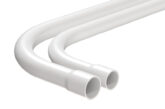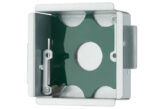
Frank Bertie, Managing Director at NAPIT, discusses concealed cabling and how to deal with new and existing cabling.
Concealed wiring systems within BS 7671
When designing any electrical installation, it’s important to consider the type of cable, the routing of the wiring system, as well as the method of protecting the wiring.
For new installations, providing the correct wiring system is selected, including any requirements for mechanical and additional protection, there shouldn’t be any issues in complying with BS 7671.
Chapter 52
Selection and Erection of Wiring Systems Chapter 52 covers the requirements on types of wiring systems and how they are to be installed. Section 522 looks at external influences, and while all of these can affect the wiring system, the one we need to consider here is the impact outlined in Regulation 522.6.
Part of Section 522 discusses the protection that is required for the appropriate parts of the wiring system.
Particular consideration is needed for any changes of direction of the wiring system and where such wiring enters any electrical equipment. So, when considering any such protection, it’s those parts of the wiring system that may be subject to damage from mechanical stress.
This Regulation details concerns regarding protection, and in particular impacts with the external influence category (AG), and has the requirement to minimise damage during erection as a result of mechanical stress caused by:
• Impact
•Abrasion
•Penetration
•Tension;
•and Compression
The important thing to remember is this requirement applies during installation, use or maintenance of the electrical installation, so factors have to be considered – not just during the installation stage, but for the expected lifetime of the installation.
As a result, such protection is required during the erection of the electrical installation in order to prevent any damage caused by any other trades working on the premises that can subject the wiring system to any of the previous categories listed under Regulation 522.6.
Within the electrical industry, it’s fundamental to have widespread understanding of where cables can be installed within the prescribed zones to meet the requirements of BS 7671.
Unfortunately, other trades and clients may not have this knowledge or may be unaware of these zones.
It’s possible that this may lead to damage to the concealed cables when other trades install their equipment, enclosures and supports, often prior to the final fix and energisation of the electrical installation, resulting in unexplained faults.
For domestic and similar installations, the cable types in use are Polyvinyl Chloride (PVC) insulated and PVC oversheathed cables in accordance with British Standard BS 6004. As they lack inherent mechanical protection, they must be positioned at least 50 mm away from any surface to avoid the risk of being penetrated by nails, screws and the like.
Where such cables pass through a joist within a floor or ceiling construction or under floorboards, they must be at least 50 mm from the top or bottom as appropriate to the joist or batten, as shown in Fig 1.
There may be situations where similar unprotected cables are concealed within walls and partitions. It isn’t usually practical to provide such cables with earthed mechanical protection such as steel conduit.
For cables less than 50 mm from the wall surface, the most practical option is to restrict the run of cables to the prescribed zones horizontally or vertically to switchgear or accessories, as detailed in Regulation 522.6.202 (i) and as shown in Fig 2.
Where access can be gained to the other side of the wall or partition, an indication of the location of an outlet point, and the possible position of cables from the reverse side of the partition, can be given by simply looking at the other side prior to carrying out the drilling or cutting into the wall or partition.
Installing a socket-outlet on one side of the partition and a blank plate on the reverse side is another option. Although not always practical, this gives a clear indication that cables may have been installed vertically or horizontally to such points on both sides of the wall or partition.
In some commercial installations, prewired metal flexible conduit is being utilised either from under floor power tracks or direct from the Distribution Boards as a means to reduce installation times.
While this type of wiring has its advantages, if the location in which it is installed fails to comply with a depth of more than 50 mm or is installed in metal partitions, then Regulation 522.6.202 is applicable (see Fig 3).
This Regulation requires that the cable concealed in the metal partition wall must be additionally protected by a 30 mA RCD or it must be mechanically protected in accordance with Regulation 522.6.204.
The requirement in Regulation 522.6.204, which relates to conduit, is contained in item (ii). This refers to earthed conduit which satisfies the requirements of BS 7671 for a protective conductor; however, flexible metal conduit cannot comply with this particular requirement.
As a result, unless mechanical protection is provided for the flexible metal conduit by some other means to prevent penetration of the cable by nails, screws and the like – such as that referred to in item (iv) of Regulation 522.6.204 – the use of flexible metal conduit alone cannot comply with the requirements of Regulation 522.6.204.
In areas where there is a higher potential of damage from impact from either medium severity (AG2) or high severity (AG3), protection shall be provided by one of the following:
• Mechanical attributes of the wiring systems (or)
• Location of the wiring system (or)
• Provision of additional local or general protection (or)
• Any combination of the above.
Concealed cables in existing electrical installations
It’s one of the main dilemmas associated with the addition or alteration of existing electrical installations where there is the danger of penetrating concealed cables, leading to a risk of fire or electric shock.
Concealed cables that are not protected are susceptible to damage due to penetration by nails, screws and other sharp objects.
Although concealed cables have had requirements for installation within safe zones and/or mechanical protection or additional protection in the form of an RCD since the 16th Edition of BS 7671, there are a multitude of premises with hidden cables without appropriate protection or routing in the correct zones.
It’s always prudent to check accessories or equipment for expected routing of cables and to use a cable detector if there’s any suspicion of concealed cables.
Conclusion
When considering the design of an electrical installation it’s important to take into account the proposed cable routes and the potential dangers of penetrating concealed cables.
For more information on NAPIT Scheme registration, click here
Find more industry technical articles here











